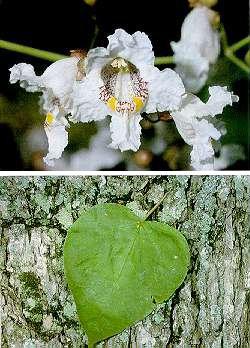- Catalpa
:"For the historical incident involving a ship of this name, see
Catalpa rescue . For the album by Jolie Holland, seeCatalpa (album) ."Taxobox
name = Catalpa

image_width = 240px
image_caption = "Catalpa speciosa" flowers, leaf and bark
regnum =Plant ae
divisio = Magnoliophyta
classis =Magnoliopsida
ordo =Lamiales
familia =Bignoniaceae
genus = "Catalpa"
genus_authority = Scopoli
subdivision_ranks = Species
subdivision = 11 species, including: "Catalpa bignonioides " "Catalpa bungei " "Catalpa fargesii " "Catalpa longissima " "Catalpa ovata " "Catalpa punctata " "Catalpa speciosa " "Catalpa tibetica "Catalpa, also spelled Catawba, is a genus of mostly
deciduous tree s in theflowering plant familyBignoniaceae , native to warm temperate regions ofNorth America , theWest Indies , and easternAsia .Catalpas typically grow to 12-18 m (40-60 ft) tall and 6-12 m (20-40 ft) wide. A 10-year-old sapling will stand about 6 m (20 ft) tall. They can be recognized by their large heart-shaped to three-lobed leaves, showy white or yellow
flower s in broad panicles, and in the autumn by their 20-50 cm longfruit s which resemble a slenderbean pod, containing numerous small flat seeds, each seed having two thin wings to aid wind dispersal. Because of the leaves, they are sometimes confused forTung tree s in the south U.S.Due to their large leaf size, Catalpas provide very dark shade and are a popular habitat for many birds, providing them good shelter from rain and wind. These trees have very little limb droppage, but drop large bean pods during late summer. The wood of catalpas is quite soft [ [http://www-pub.naz.edu:9000/~treewalk/catalpa/catalpa.htm catalpa ] ]
The two
North America n species, Southern Catalpa ("Catalpa bignonioides"), and Northern Catalpa ("Catalpa speciosa") have been widely planted outside their natural ranges as ornamental trees for their showy flowers and attractive shape, or growing habit. Northern and Southern Catalpa are very similar in appearance, but the northern species has slightly larger leaves, flowers, and bean pods. Flowering starts after 275growing degree day s. The Yellow Catalpa 梓樹 ("Catalpa ovata") fromChina , with pale yellow flowers, is also planted outside its natural range for ornamental purposes.The name derives from the Catawba Native American name catawba for these trees (the tribaltotem ), with the spelling "Catalpa" being due to atranscription error on the part of the describing botanist (Scopoli) making the first formal scientific description of the genus. The rules of botanical naming state that the spelling used in the formal scientific description has to be retained for the scientific name. The name in vernacular use has very largely (though not completely) followed Scopoli's erroneous transcription, with catawba still in use in some areas of the United States, most particularly within the trees' native range.The bean-like seed pod is the origin of the alternative vernacular names Indian Bean Tree and Cigar Tree for "C. bignonioides" and "C. speciosa".
The tree is the food plant of the
Catalpa Sphinx moth, the leaves being eaten by thecaterpillar s. The caterpillars are an excellent live bait for fishing, particularly in the south U.S. where some dedicated anglers plant catalpa mini-orchards for their own private source of "catawba-worms".The largest living Catalpa tree is on the lawn of the Michigan State capitol and was planted in year of its dedication. The oldest is the 150-year-old specimen in the Minster graveyard of St Mary’s Butts in the UK town of
Reading, Berkshire . The council has removed the deadwood and trimmed its branches to prevent its collapse. The trunk remains alive but in poor health. A replacement tree has already been planted to pre-empt its eventual loss.Catalpa is also occasionally used as a
tonewood in guitars.References
External links
* [http://www.cas.vanderbilt.edu/bioimages/species/frame/casp8.htm "Catalpa speciosa" images at bioimages.vanderbilt.edu]
* [http://www.reading.gov.uk/news/councilnews/NewsArticle.asp?id=SX9452-A7821BC8 Reading Borough Council report on essential action to save Catalpa tree]
Wikimedia Foundation. 2010.
